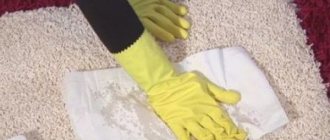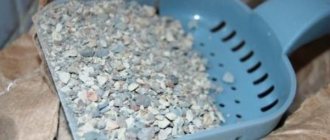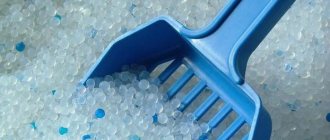Pets are our friends who cheer us up and help us relax after work. But caring for them can be difficult, especially in an apartment, when the animal does not go outside or prefers to do all its business in the house. Cat litter helps with hygiene issues, but the area may still smell unpleasant. And this is not what the owners of furry four-legged animals want to see. Therefore, today we will look at how to get rid of the smell of cat litter and keep your home clean if you have pets.
Tray selection
Regular removal of excrement from the cat litter box, timely change of litter and periodic general cleaning will ensure the absence of unwanted odor in the house. But what if the owner does not have the opportunity to clean the toilet with the required frequency? In this case, you should take a closer look at special trays that do not allow the smell to spread.
Closed
Such a toilet not only keeps all the aromas inside, but also minimizes the scattering of the filler when buried. It is also perfect for those pets who do not like to relieve themselves in front of everyone. Manufacturers offer a wide selection of models with or without a door, corner and straight toilets.
Dry toilet
This is a fairly large product, equipped with a carbon filter and a fan. It eliminates unpleasant odors well, but requires regular filter changes.
You can learn about the intricacies of choosing a cat litter box from the video:
With automatic cleaning
These types of trays are high-tech devices that are capable of sifting, collecting and removing contaminated filler, using sewerage and water supply. The price of such toilets is quite high, but the owners do not have to waste time on cleaning and endure unpleasant odors.
As practice shows, owners who keep their cat litter clean do not encounter such a problem as an unpleasant odor. We hope that our tips will help simplify the process of cleaning up after your pet.
Caring for your cat's litter box
Caring for your cat's litter box is not difficult. The main actions of the cat owner are:
- timely cleaning of solid animal feces;
- regularly changing urine-soaked litter in the container;
- washing the tray.
If all actions are carried out regularly and in full, then the animal will not relieve itself by passing or do it in unintended places.
Animals from the order of cats are distinguished by their intelligence and have excellent memory. Their habit is to bury the products of their vital activity in the ground so that “enemies” cannot find them by smell. This is why cat litter is filled with cat litter. Also, by smell, they find pairs for procreation, mark and limit “their” territory, and the kittens, thanks to their heightened sense of smell, find the litter box and become accustomed to visiting it. And that is why adult animals ignore places to relieve themselves that are kept in poor order by the owners of the animals.
Dietary disorders, stress, age-related changes in the animal’s body and other external factors lead to the animal’s urine becoming caustic and salts forming in it. Fresh deposits can be removed when replacing the filler, but uric acid or oxalates can only be removed mechanically.
By my rules
Proper washing of the cat's litter box is the key to freshness and a pleasant smell in the apartment. The sequence of actions of this process depends entirely on the design and shape of the cat litter being used.
Open trays need to be cleaned more often than closed trays. Daily cleaning generally does not require a complete change of litter; it will be enough to collect the excrement and then dispose of it in accordance with the recommendations indicated on the packaging of the desiccant mixture.
If the cat relieves itself not in the litter itself, but on the grate, then it is recommended to wash it with each cleaning. For this purpose, it is advisable to use special products designed for sanitizing cat litter. The action of such products is aimed at the complete sanitization of cat litter, so the substance can easily cope with the smell of urine and prevent the deposition of salts.
General cleaning of the cat litter is carried out in the order listed below:
- Empty the tray. Unused filler (especially silicone) can be collected in a separate container and reused.
- Fill the tray with warm water up to the ears, and soak the grate in a separate container.
- We leave the tray with water for ten minutes, and then rinse it and drain the water from the pan.
- Place the tray and grill in a bowl of soapy water, and then leave them there for half an hour.
- After the time has passed, drain the dirty water and treat the surface of the cat litter with a detergent and then scrub with a brush.
- Carefully rinse off any remaining soap and rinse the containers clean.
- We wipe the tray and grill dry or dry it in the fresh air.
Some cat owners recommend having two replaceable trays so that the animal does not experience discomfort while sanitizing its litter box.
Despite the fact that a cat or cat is undoubtedly a favorite, and caring for them is not a burden or disgusting, all work on disinfecting a cat's litter box should be done exclusively with rubber gloves. This will not only protect the skin of your hands from exposure to household chemicals, but also protect against toxoplasmosis. This disease is especially dangerous for pregnant women. Its causative agent, entering the body of the expectant mother, can cause deformities and other abnormalities in the child in the womb.
To wash all parts of the tray, you can use traditional detergents and chlorine-containing substances (Domestos, Belizna and others), as well as special compounds that eliminate the smell of cat urine. When disinfecting the toilet with special chemicals, there is no fear of the formation of urinary stones on the surface of the container. Sprays and powders not only eliminate simple dirt and the specific smell of urine, but also fight pathogens.
If you do not have such means, then you can wash the trays with laundry detergent or any detergent compositions, including improvised ones. But as a result of this, everyone will inevitably have to face other problems. Read about them and their solution below.
Clearing urinary stones
Often, cat owners wash the litter box just to keep the smell out of it. But they forget that untimely or incorrect cleaning of the tray, as well as the use of inappropriate surface treatment products, lead to the deposition of urinary stones. The manifestations of this unpleasant phenomenon are:
- foul odor;
- plaque, noticeable as growths that are rough to the touch;
- refusal of the animal to visit the tray.
An animal that relieves itself in a tray with stone deposits will spread the “aroma” throughout the apartment on the pads of its paws. To avoid urine transfer, and with it possible infection, attention should be paid to combating natural salts.
Video
Some more useful information is presented in the video below:
Text: Nadezhda Chernobay
Found a mistake? Select the text with the mouse and click:
Fresh lemon is not only suitable for tea: clean dirt from the surface of an acrylic bath by rubbing with half a cut citrus, or quickly wash the microwave by placing a container of water and lemon slices in it for 8-10 minutes at maximum power. The softened dirt can simply be wiped off with a sponge.
Threads made of gold and silver, which were used to embroider clothes in the old days, are called gimp. To obtain them, the metal wire was pulled for a long time with pliers to the required fineness. This is where the expression “to drag out the rigmarole” came from - “to do long, monotonous work” or “to delay the completion of a task.”
The habit of using an automatic washing machine “sparingly” can lead to the appearance of an unpleasant odor in it. Washing at temperatures below 60℃ and short rinses allow fungi and bacteria from dirty clothes to remain on internal surfaces and actively multiply.
The dishwasher cleans more than just plates and cups. You can load it with plastic toys, glass lamp shades and even dirty vegetables, such as potatoes, but only without using detergents.
The easiest way to remove scale and carbon deposits from the soleplate of the iron is with table salt. Pour a thick layer of salt onto the paper, heat the iron to maximum and run the iron over the salt bed several times, applying light pressure.
There are special traps to combat moths. The sticky layer with which they are covered contains female pheromones that attract males. By sticking to the trap, they are eliminated from the reproduction process, which leads to a decrease in the moth population.
Before removing various stains from clothing, you need to find out how safe the selected solvent is for the fabric itself. It is applied in a small amount to an inconspicuous area of the item from the inside out for 5-10 minutes. If the material retains its structure and color, you can move on to stains.
If your favorite things show the first signs of gestation in the form of untidy pellets, you can get rid of them using a special machine - a shaver. It quickly and effectively shaves off clumps of fabric fibers and returns things to their proper appearance.
Stretch ceilings made of PVC film can withstand from 70 to 120 liters of water per 1 m2 of their area (depending on the size of the ceiling, the degree of its tension and the quality of the film). So you don’t have to worry about leaks from neighbors above.
How to remove from various surfaces
To successfully combat odors and puddles left by your cat, you need to determine what is suitable for specific surfaces. The same products cannot be used to clean carpet and floor piles.
From upholstered furniture
To clean a sofa, armchair, chair that has been damaged by your pet, you need to choose non-aggressive products. It is better to first check how the fabric reacts to the washing solution prepared for washing. Apply the cleaning liquid to the edge of the fabric and watch the reaction for several minutes. A solution of vinegar, soda and hydrogen peroxide cleans stains well. For professional ones, DuftaPet and Zoosan are suitable.
Carpets
If the floor is completely carpeted, cats often sit down to pee. Urine completely saturates the pile if the puddle is not removed immediately. Quickly blot the stain and sprinkle absorbent powder on top. Soda and salt will do. You can clean carpets with a solution of vinegar, and dark carpets with iodine and potassium permanganate.
From the mattress
Adult cats trained to sleep with their owners can mark their territory. If you find a puddle on the bed mattress, you should sprinkle baking soda on it and pour hydrogen peroxide on top. You can also use mineral water with salt. You should then wipe the stain with warm water and soap.
From shoes
When a cat pees in its owner's shoe, it is quite difficult to remove the smell. Fresh puddles are immediately blotted with a napkin. Then you need to wash the inside with water and laundry soap. You will have to carry out the procedure more than once, as the smell does not go away well. Dry your shoes in the fresh air by pushing crumpled paper inside. Sneakers and sneakers can be washed with powder.
From clothes
Getting rid of cat urine on clothes is simple: you need to wash it in a machine or by hand with laundry soap. Then rinse in water adding acetic acid. Dry in fresh air.
Plants
When the cat decides to go to the toilet in the flowers, you need to remove the plant from the windowsill. All that remains is to transplant it into another pot, completely changing the soil. It is advisable to move the animal’s favorite flower to another place where the cat cannot enter. You can neutralize the odor by sprinkling the soil with activated carbon powder.
Tree
Stains on wooden floors are washed off with soapy water. Afterwards it is better to wipe with a vinegar solution. You should rinse several times with the window slightly open. It is effective to spray the surface with mineral water and vinegar. Then be sure to rinse the floor clean.
Linoleum and laminate
The best solution for these surfaces is a vinegar solution. The solution is washed several times to completely remove the smell. On dark surfaces you can use a pink solution of potassium permanganate.
How to get rid of cat litter smell
Pet owners get so used to their presence in the house that they often do not feel the specific aroma that comes from the litter box. This is not surprising, because pets still do their delicate things there. The question arises: how to get rid of the smell of cat litter?
Regular washing with running water does not help much. However, there is a lot of advice floating around on the Internet, smart and not so smart. Let's look at the most common of them, evaluate their effectiveness and deal with myths.
Why is it so difficult to eliminate
A cat that makes its toilet in hard-to-reach corners or on the carpet leaves marks and odors. The whole apartment suffers from them. And most importantly, it is difficult to remove these aromas: neither daily floor washing nor carpet cleaning helps. And the stench occurs due to the composition of the biological fluid. It contains both a coloring substance, urochrome, and an acid, which gives off a pungent odor. If a puddle on the floor is easy to clean up, the smell is very difficult to get rid of. It remains for a long time even after using concentrated acids.
Timely cleaning plays a big role in getting rid of cat odors. It is easier to deal with fresh stains than old ones.
Wash the tray
Sorry, you can wash the tray with just water, or you can add some product. Let's figure it out together.
Pure water. Advantages: none.
Disadvantages: it only removes the color of urine, does not dissolve urine crystals and limestone, the smell of urine appears after an hour.
White. Benefits: removes odor.
Disadvantages: burns the skin and mucous membranes, discourages the pet from going to the litter box, short-term effect.
Vinegar. Advantages: Reduces unpleasant odor for a short time.
Disadvantages: it stinks worse than urine, does not remove limestone.
Laundry soap. Benefits: dissolves urine crystals, removes odor for a long time.
Disadvantages: does not remove limescale.
- give your pet boiled or settled water
- don't salt his food
- Wash the tray more often.
If these three conditions are met, there will be virtually no gray plaque in the tray, and your cat will have healthy kidneys.
Advice. It is recommended to replace the cat litter container itself with a new one at least once a year. The fact is that plastic is not ideally inert to the aggressive components of urine. Yes, and detergents gradually corrode the surface. Therefore, the smell is absorbed over time, and it is impossible to wash it away with anything.
Causes of persistent unpleasant odor
It is clear that without understanding the reasons why cat urine has such a persistent and strong odor, it is completely useless to think about how to remove the cat odor. You don’t need to be a professional chemist to figure it out and then find methods to eliminate the problem.
Photo from the site: 29palms.ru
- Uric or uric acid is our main “enemy”, which is the most difficult to fight. This substance dries out very quickly and crystallizes, after which it is practically insoluble either in water or in most household cleaning products. But it dissolves well in acidic environments, which is why vinegar, citric acid, and alkali solutions are called effective.
- The second component of urine is urochrome, a substance that gives the liquid a persistent yellow tint that leaves stains. It washes off quite well with any cleaning solution, but best of all with glycerin soap.
- Urea gives the cat’s “surprises” stickiness; it is easily washed off with plain water, and this definitely won’t cause any problems.
Uric acid “knows how” to camouflage itself very well. That is, when cleaning up traces of a “crime,” you can mask the unpleasant odor with aromatic fragrances, but after they dissipate and moisture gets on the acid crystals, they will “smell” even more strongly. It is more difficult to remove the smell of urine from soft surfaces, for example, from furniture, but easier to remove from the floor. The main thing is that urine does not seep through or be absorbed into the floor covering, otherwise it will have to be replaced completely or at least partially.
Freshen the air
Some “experienced” cat owners recommend very inadequate means to get rid of the smell of cat litter. In particular, they advise not to worry about timely litter box hygiene, but simply to freshen the air. In this case, the following tools are offered:
- Spray the room with a household air freshener.
- Place fresh citrus peels throughout your home.
- Boil a few milliliters of vinegar in an open frying pan.
- Spray around with eau de toilette.
- Place pieces of cotton wool soaked in perfume around the room.
- Boil some ammonia in a ladle.
Can you imagine what kind of amber will float from the windows of your home if you use at least one of these tips? Yes, you yourself will not be able to go home without collapsing into a deep faint. And if you rise from it, you will collapse again. You'll have a fight with your neighbors, the police will come and sort things out - where does that stink come from? Therefore, we urgently ask you to send such cat lovers on the well-known erotic walking journey. And regularly practice cat litter hygiene.
Choose a filler
Some owners are greedy for good litter for the tray. They use newspapers, sand, toilet paper and the like. Then they complain about the unpleasant smell. Not surprising. Try doing delicate things yourself in a similar pot. You won't feel this way yet.
Remember, proper maintenance of a pet always involves certain material costs. Including a good filler. Just don't argue now! Good is not at all a synonym for the word expensive. A budget filler may well turn out to be of decent quality. Moreover, today the veterinary industry offers several types to suit every taste and budget:
- wood (cheapest)
- mineral (higher price category)
- silica gel (most expensive)
The operating principle of all fillers is the same - absorb liquid and odor. But the work scheme is different. Wood gel swells, mineral gel sticks together, silica gel clumps. But that's not the point. The most important thing is that even the cheapest litter gets rid of the smell of cat litter many times better than newspaper or sand. By the way, they start to stink almost immediately.
But that's not all. It is recommended not to wait until your pet’s litter box starts to “smell”. It is advisable to remove already swollen lumps, replacing them with fresh filler. So you definitely won’t feel the scent of the cat’s delicate affairs for a long time.
Causes of odor
Of course, the toilet itself can no longer smell pleasant. But some factors aggravate the problem, causing an unpleasant odor in the room. What reasons lead to this result?
1. The tray does not change for a long time.
2. Cleaning the tray is superficial; dirty particles remain at the bottom.
3. The animal goes to the toilet past the tray or spreads the remains with its paws.
4. The filler does not cope with odor removal.
Also, the cause of the pungent odor may be the animal’s poor diet. In any case, we know what to do.
Special means
Sometimes this happens: the owners carefully monitor the cleanliness of the cat litter, wash it, clean it, but the smell is still noticeable. What to do if there is a smell from the litter box? In this case, the veterinary industry offers special remedies. Most often they are produced in the form of aerosols. No, you don't need to spray them around the room.
Their operating principle is based on enzymes and enzymes that are included in the composition. They dissolve uric acid crystals, while reliably locking away the unpleasant odor. Just a few sprays are enough and the heavy spirit will leave your home.
It is very important that most of these products are absolutely safe for pets and do not cause rejection or damage to their sense of smell.
Advice. If you choose this option, be sure to read the reviews before purchasing. Recently, cunning businessmen have thrown a lot of fakes onto the market that do not give any effect. Buy only proven products from well-known brands. By the way, their price range is quite wide. And follow the instructions strictly! After all, this is an enzyme preparation, and not a home air freshener.
What not to use
The success of the fight against bad odors depends on the correct steps of the housewife. Usually they try to overpower them with other, stronger aromas. But they get such a sickening stench that you want to run out of the house for fresh air.
Aromatics
To remove odors, you need to use products that can break down the components of cat urine.
Using aromatic substances to refresh the body or air will not achieve results.
Ground coffee
Coffee beans are needed to remove unpleasant odors from the kitchen. You can temporarily reduce the effect of aromas, but you won’t be able to completely remove them. And if you sprinkle coffee powder on a stained carpet, the smell will not disappear, but will only intensify.
Aroma oils
Cat urine is known to be oily. If you pour more oils of fragrant plants and flowers onto the stain, it will be difficult to wash the fabric later. And the smell will become even more foul.
Deodorants
Volatile substances in deodorants can temporarily cover up the bad odors of cat urine. But after half an hour the stench will become even stronger. When mixed with cosmetic scents, it will be a hundred times more unpleasant.
Fragrant herbs
Many fragrant herbs attract the attention of cats. They love the smells of valerian and motherwort. If you sprinkle crushed aromatic herbs on the stain, the cat may make another puddle nearby.
Chlorine-based detergents
Aggressive agents with chlorine are used to disinfect the room. But they are not used against cat urine. They can only increase the smell and spoil fabrics and coverings soiled by the cat.
Castration
Some people believe that if they neuter their pet, they can avoid unpleasant litter box odors. This statement is only partly true. Because the operation must be carried out strictly until a certain age (this applies to both cats and cats).
And it happens that the animal is already more than a year old, the owners sniff it and run to the clinic. Unfortunately, in this case, castration will not solve the problem. There will still be a specific stench coming from the cat litter box.
Advice. If it seems to you that the smell is not coming from the litter box, but you cannot find the stain, then purchase a flashlight with ultraviolet black light. With its help, you can easily find the place where the insidious pet managed to play a mischief. The device, unlike a lamp, can be purchased for a very reasonable price. But you won’t have to sniff every corner, climb behind cabinets and crawl under tables.
How to get rid of cat litter smell? It turns out that this is a difficult, but completely doable task. You just need to always turn your head on and think in the right direction. Then your home will have the aroma of freshness, and not the heavy amber of pet urine.
Useful tips
In conclusion of the article about the rules for washing a cat's litter box, I would like to draw attention to useful tips from admirers of “indoor” cats. They relate not so much to the washing process itself, but to the rules for using devices and choosing adsorbents.
- Do not use the tray without filler! Accustom your animal to adsorbents from early childhood, otherwise you cannot avoid a stench in the room. If the kitten does not like one hygiene product, then replace it with another until you decide on the most comfortable option for everyone.
- Always fill trays only with high-quality absorbents and mixtures. The best choice would be substances without fragrances.
- For toilets of adult animals, do not use “baby” mixtures and compositions, as well as fine fillers.
- Give small kittens a mixture that will not attract their attention and will not be used as a toy (or worse, eaten!).
- Keep the cat's litter box clean and feces collected in a timely manner.
- Do not skimp on the quality of the tray, because a product of lower quality will quickly become overgrown with stones and will exude an amber.
- Do not add citrus-scented deodorants to filler mixtures and do not use household chemicals with such fragrances.
- Control your animal’s diet, don’t skimp on vitamins, and visit the veterinary clinic regularly.
One of the life hacks is to use a garbage bag as a bedding for the filler (as in the photo). This method has proven itself in the fight against unpleasant odors and urinary stone deposits. It also makes it much easier to dispose of used litter. But this method is only suitable if the cat does not scratch the filler much or when using a grid.
To summarize the article, I would like to note the fact that cat litter trays have a limited service life. If an unpleasant aroma remains after washing and completely replacing the filler, then this means that “X” time has come. Cheap potty models generally need to be replaced about once every twelve months, while more modern units need to be replaced every three years.
Cat urine is high in ammonia, which inevitably leads to an unpleasant odor in the house. Therefore, almost every owner sooner or later faces the problem of how to wash a cat’s litter box so that there is no smell.
From the article you will learn how to properly clean cat litter and what products should be used to completely get rid of the problem.











